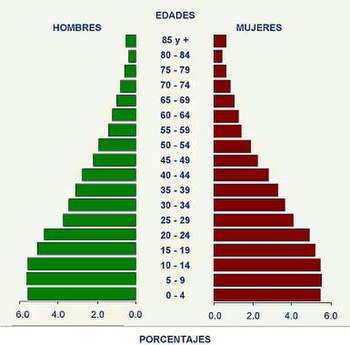Demographics of Ecuador
The demographics of Ecuador according to data published by the INEC on the 2010 population and housing census, showed certain peculiarities of the evolution of the country's behavior and also reflects an improvement and tendency of behavior to have the demographics of a developed country. Among some characteristics, the access to technologies by its inhabitants that reaches a considerable percentage: The population pyramid shows an increasingly perpendicular trend, which denotes a lower number of children per couple, a higher percentage of older adults, and a population that is currently of working age.
Between the 1990 and 2001 censuses, Ecuador experienced a demographic growth of 2.6 million inhabitants, from 9.6 million to 12.2 million inhabitants. Between the 2001 and 2010 censuses, it grew another 2.3 million to 14.5 million inhabitants.
Population
Total population
18 113 547 (2022)
Projections
- Year 2030: 19 818 798
- Year 2040: 21 762 362
- Year 2050: 23 316 454
- Year 2060: 24 415 659
- Year 2070: 25 036 853
- Year 2080: 25 203 001
- Year 2090: 24 998 789
- Year 2100: 24 482 822
Source: Ecuador - Population 1950 - 2100
Demographic evolution
- Year 1492 is estimated at 500 000 to 1 000 people.
- Year 1570, is estimated at 1000 indigenous, 6000 Spanish and 10 000 castes and slaves.
- 1650, estimated at 580 000 inhabitants, there were 450 000 shelters, 400 000 whites and 900 slaves (black) and caste.
- Year 1826, first medianly accurate census, 550,700 people.
- Year 1830, as he separated from the Great Colombia, there were half a million inhabitants, 90% cobriza and mestiza.
- Year 1835, estimated at 600 000
- Year 1836, estimated at 706 320
- Year 1839, estimated at 751 116
- Year 1846, medianly accurate census, there are 869 892 souls, 52% white, 41% blankets, 4% free browns, brown slaves 1%, black free 1% and black slaves 1% (the category of "mestizos") is not included.
- Year 1849, estimated at 965 250
- Year 1854, estimated at 1 065 500
- Year 1855, estimated at 1 086 981
- Year 1856, estimated at 1 108 042
- Year 1882, estimated at 950 000
- Year 1905, estimated at 1 150 000
- Year 1920, estimated at less than 1 500 000
- In 1950, another census counted 3 211 916 persons.
- Year 1962, another census, 4 564 080 people.
- 1974, another census, 6 521 710 persons.
- 1982 census, 8 138 974 persons.
- 1990 census, 9 697 979 persons.
- 2001 census, 12 156 608 persons.
- Year 2011, census, 14 483 499 persons.
It is believed that in the future the Ecuadorian population will undergo an aging process, although this will not be as drastic as the countries of the Southern Cone, the following table represents that process.
| Year | Population over 60 |
|---|---|
| 2000 | 876,000 |
| 2025 | 2.235,000 |
| 2050 | 4.643,000 |
| Graphic of demographic evolution of Ecuador between 1826 and |
 |
Illiterate Population
In Ecuador, people over the age of 20 who cannot read and write are considered illiterate. The national illiteracy average is 3.8 percent. The national average for digital illiteracy is 9.4 percent. This refers to people who do not have basic knowledge of handling technologies such as: mobile telephony, Internet, among others. The average years of schooling for people >=10 years is 7.8
Migration
Between 1996 and 2006, the country's political and economic instability led a tenth of the population to emigrate, mainly to Spain and Italy, and to a lesser degree to the United States.
Despite this emigration, Ecuador is a host country for thousands of people who come mostly from its neighboring countries such as Colombia, where the armed conflict has displaced hundreds of thousands of people, Ecuador also welcomes Peruvians, Bolivians and Venezuelans, where conditions lead to labor migration attracted by the opportunity to earn wages in US dollars. Unofficial figures for these communities estimate them to be more than half a million Colombians and 200,000 Peruvians. Other migratory groups worth mentioning are citizens of Cuba, Venezuela, the United States, China, Russia, and Eastern Europe, estimated to number in the thousands, but it is understood that they have a temporary presence since their main objective is to move to other countries.
Population Structure
Men: 6'830,674 Women: 6'879,560
According to Age:
0-14 years:
34.9% (men 34,430,303; women 35,551,166)
15-64 years:
60.6% (men 4,116,289; women 4,198,667)
65 years and over:
4.5% (males 284,082; females 329,727) (2003 est.)
Middle Ages:
All:
28.4 years (2010)
Men:
22 years
Ethnography
The National Institute of Statistics and Censuses (INEC), in its 2010 population and housing census, found the following ethnic composition:
|
Sexuality
- Sexual diversity in Ecuador
Contenido relacionado
Stone Fountain Lagoon
PRD
Salvatierra Berrocal
